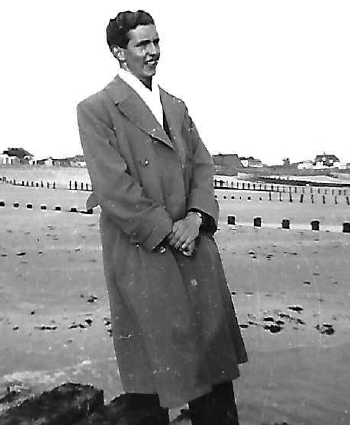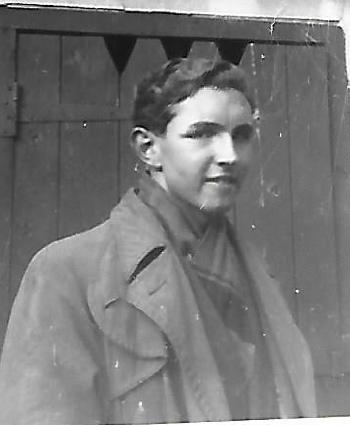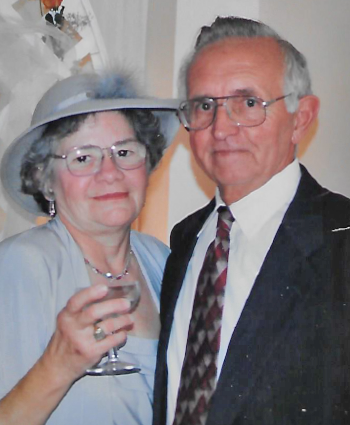April 7, 2016
Casey van Maris considered the father of Landscape Ontario
Long before Landscape Ontario was formally created on Jan. 24, 1973, Casey van Maris had worked tirelessly behind the scenes to convince industry members on the advantages of combining small associations that served the respective sector groups.
He also campaigned in a public manner through his column, Casey’s Corner, published in the industry’s newsletter, the Landscape Gardener. In 1976, he was given the Garden Writers’ Award for his columns.
Landscape Gardener. In 1976, he was given the Garden Writers’ Award for his columns.
In his column of June 1972, he outlined his proposals for unity of the associations of the horticulture industry. Each association was to have two members on the unified board for a one year term. Board members appoint chair, co-chair and secretary-treasurer.
The objective of new association was to combine newsletters, meetings, social activities, Congress, government representation and education. He wrote, “In my opinion we must unite in order to gain our fair share of the consumer dollar, and united we could rise to become one of the most important industries in the province.”
He also proposed that the association be divided into Chapters, with each Chapter divided into groups for growers, garden centres, contractors, maintenance, florists, sod growers and greenhouse operators.
The associations at the time that all voted to come into the combined association included the Ontario Nursery Trades Association, Ontario Garden Maintenance and Landscape Association and Ontario Landscape Contractors Association. The first president was Glenn Peister, with Casey van Maris as first vice-president. He became president in 1974. The group appointed Burke McNiel of Department of Agriculture as an independent person to chair the meetings to organize Landscape Ontario.
The Chapters that composed Landscape Ontario were Hamilton, London, Ottawa, Toronto and Windsor. The commodity groups included growers, landscaping, garden centres and maintenance. The sod growers were to come into the fold, but pulled out before Landscape Ontario became reality.
A few months after the association was officially formed, van Maris wrote, “We need Landscape Ontario as a potent, driving force for our industry. Through our collective (united) strength, we can make things happen and work for us without waiting for ‘panic situations’ to arise, requiring all of us to scramble around madly in an effort to correct the situation. I feel many benefits will result in our second year, 1974.”
During this time, van Maris had the complete support of his wife Monica in not only in his business Parklane Landscapes and at home, but also deeply in the association. She became the first female president of Landscape Ontario in 1987.
 Casey van Maris passed away in 1997, at the age of 64. At the time, there was a collective voice that stated, “Landscape Ontario lost one of its most influential and respected members, a founder of the association - Mr. Casey Van Maris. To honour his memory, Landscape Ontario has developed an award which will carry on the legacy of a great friend to the association and industry. The Casey Van Maris Award is given to the project awarded the highest marks for execution of unique and innovative design in landscaping.
Casey van Maris passed away in 1997, at the age of 64. At the time, there was a collective voice that stated, “Landscape Ontario lost one of its most influential and respected members, a founder of the association - Mr. Casey Van Maris. To honour his memory, Landscape Ontario has developed an award which will carry on the legacy of a great friend to the association and industry. The Casey Van Maris Award is given to the project awarded the highest marks for execution of unique and innovative design in landscaping.
As well, a scholarship under his name was created to be given to secondary students entering the first year of a post-secondary ornamental horticulture program of an accredited educational institution. Candidates are chosen based on transcripts and a two-page essay on why they want to enter the horticultural industry.
Casey arrived in Canada in 1956, with $25 in his pocket. He had lived in England for a number of years, after moving from his homeland of Holland, where he became quite adept at soccer. In England he lived on Parklane Circle. He later used the name for his company in Canada
He married Monica in 1957. She had arrived in Canada in 1954 from British Guiana. The couple had six children.
After forming the business, Monica took over the bookkeeping, secretarial work and handling calls from the public. “I was the person customers spoke to, so I had to be nice to them,” says Monica with a smile.
With a small truck and a background in horticulture, van Maris and John van Roode began Parklane in Scarborough in 1958. The first few years were tough during the winter with the partners taking on jobs, including waxing turnips, selling cabbage from their basement, delivering fuel oil and ploughing snow. In 1972, van Roode sold his shares of the business to Monica.
The company provided landscape design, construction and maintenance. In his homeland of Holland, van Maris had trained as a landscape architect.
In 1967 Parklane added a retail garden centre. By 1975 the area around Finch Ave. property was booming. It was sold, and Parklane moved the operation near Gormley, where the company refocused on landscape design and construction. The move also ended the company’s involvement in the garden centre sector. But, with additional land, van Maris began growing caliper trees.

After a trip back to his homeland in 1982, Casey van Maris was inspired to construct a series of model gardens. His dream was to showcase the design talents of the company and to demonstrate to the public various garden styles and materials. He opened gardens in 1984. The gardens were so impressive, that a Trillium Award was given to Parklane for its efforts to contribute to horticulture.
In 1986 Casey van Maris began another chapter in his life. With the co-operation of the University of Guelph, he began research in root control growing to allow smaller root balls with maximum root structure. Casey van Maris resigned as president of Parklane to focus on the tree growing operation under the name van Maris Holdings. Daughter Anna van Maris is now president.
The history of Casey van Maris can’t be told without his love of soccer. Although his playing days were over, he brought his ability in management by becoming President of the Ontario Soccer Association, President of the York Region Soccer Association, President of the Whitchurch-Stouffville Soccer Club, and Treasurer of the Canadian Soccer Association.
His work in spearheading the Ontario Soccer Centre project in Vaughan was acknowledged in September 26, 2002, with the official opening ceremonies of the Casey Van Maris Soccer Centre. Celebrating its 25th anniversary, the Whitchurch Stouffville Soccer Club dedicated a plaque in honor of Casey van Maris.
Then in December of 2015, York Region Soccer Association officially inducted him into its Hall of Fame under the Builders Category to honour his contributions to the sport.
Over the years, Casey van Maris had many achievements in horticulture, business, sport, and construction. He brought his drive and skill to ensure success in each and every aspect of those challenges. But, his work to help create Landscape Ontario required great foresight. Today’s industry members can very thankful for that.
The following are some of the columns van Maris wrote over the years.
He also campaigned in a public manner through his column, Casey’s Corner, published in the industry’s newsletter, the
 Landscape Gardener. In 1976, he was given the Garden Writers’ Award for his columns.
Landscape Gardener. In 1976, he was given the Garden Writers’ Award for his columns.In his column of June 1972, he outlined his proposals for unity of the associations of the horticulture industry. Each association was to have two members on the unified board for a one year term. Board members appoint chair, co-chair and secretary-treasurer.
The objective of new association was to combine newsletters, meetings, social activities, Congress, government representation and education. He wrote, “In my opinion we must unite in order to gain our fair share of the consumer dollar, and united we could rise to become one of the most important industries in the province.”
He also proposed that the association be divided into Chapters, with each Chapter divided into groups for growers, garden centres, contractors, maintenance, florists, sod growers and greenhouse operators.
The associations at the time that all voted to come into the combined association included the Ontario Nursery Trades Association, Ontario Garden Maintenance and Landscape Association and Ontario Landscape Contractors Association. The first president was Glenn Peister, with Casey van Maris as first vice-president. He became president in 1974. The group appointed Burke McNiel of Department of Agriculture as an independent person to chair the meetings to organize Landscape Ontario.
The Chapters that composed Landscape Ontario were Hamilton, London, Ottawa, Toronto and Windsor. The commodity groups included growers, landscaping, garden centres and maintenance. The sod growers were to come into the fold, but pulled out before Landscape Ontario became reality.
A few months after the association was officially formed, van Maris wrote, “We need Landscape Ontario as a potent, driving force for our industry. Through our collective (united) strength, we can make things happen and work for us without waiting for ‘panic situations’ to arise, requiring all of us to scramble around madly in an effort to correct the situation. I feel many benefits will result in our second year, 1974.”
During this time, van Maris had the complete support of his wife Monica in not only in his business Parklane Landscapes and at home, but also deeply in the association. She became the first female president of Landscape Ontario in 1987.
 Casey van Maris passed away in 1997, at the age of 64. At the time, there was a collective voice that stated, “Landscape Ontario lost one of its most influential and respected members, a founder of the association - Mr. Casey Van Maris. To honour his memory, Landscape Ontario has developed an award which will carry on the legacy of a great friend to the association and industry. The Casey Van Maris Award is given to the project awarded the highest marks for execution of unique and innovative design in landscaping.
Casey van Maris passed away in 1997, at the age of 64. At the time, there was a collective voice that stated, “Landscape Ontario lost one of its most influential and respected members, a founder of the association - Mr. Casey Van Maris. To honour his memory, Landscape Ontario has developed an award which will carry on the legacy of a great friend to the association and industry. The Casey Van Maris Award is given to the project awarded the highest marks for execution of unique and innovative design in landscaping.As well, a scholarship under his name was created to be given to secondary students entering the first year of a post-secondary ornamental horticulture program of an accredited educational institution. Candidates are chosen based on transcripts and a two-page essay on why they want to enter the horticultural industry.
Casey arrived in Canada in 1956, with $25 in his pocket. He had lived in England for a number of years, after moving from his homeland of Holland, where he became quite adept at soccer. In England he lived on Parklane Circle. He later used the name for his company in Canada
He married Monica in 1957. She had arrived in Canada in 1954 from British Guiana. The couple had six children.
After forming the business, Monica took over the bookkeeping, secretarial work and handling calls from the public. “I was the person customers spoke to, so I had to be nice to them,” says Monica with a smile.
With a small truck and a background in horticulture, van Maris and John van Roode began Parklane in Scarborough in 1958. The first few years were tough during the winter with the partners taking on jobs, including waxing turnips, selling cabbage from their basement, delivering fuel oil and ploughing snow. In 1972, van Roode sold his shares of the business to Monica.
The company provided landscape design, construction and maintenance. In his homeland of Holland, van Maris had trained as a landscape architect.
In 1967 Parklane added a retail garden centre. By 1975 the area around Finch Ave. property was booming. It was sold, and Parklane moved the operation near Gormley, where the company refocused on landscape design and construction. The move also ended the company’s involvement in the garden centre sector. But, with additional land, van Maris began growing caliper trees.

After a trip back to his homeland in 1982, Casey van Maris was inspired to construct a series of model gardens. His dream was to showcase the design talents of the company and to demonstrate to the public various garden styles and materials. He opened gardens in 1984. The gardens were so impressive, that a Trillium Award was given to Parklane for its efforts to contribute to horticulture.
In 1986 Casey van Maris began another chapter in his life. With the co-operation of the University of Guelph, he began research in root control growing to allow smaller root balls with maximum root structure. Casey van Maris resigned as president of Parklane to focus on the tree growing operation under the name van Maris Holdings. Daughter Anna van Maris is now president.
The history of Casey van Maris can’t be told without his love of soccer. Although his playing days were over, he brought his ability in management by becoming President of the Ontario Soccer Association, President of the York Region Soccer Association, President of the Whitchurch-Stouffville Soccer Club, and Treasurer of the Canadian Soccer Association.
His work in spearheading the Ontario Soccer Centre project in Vaughan was acknowledged in September 26, 2002, with the official opening ceremonies of the Casey Van Maris Soccer Centre. Celebrating its 25th anniversary, the Whitchurch Stouffville Soccer Club dedicated a plaque in honor of Casey van Maris.
Then in December of 2015, York Region Soccer Association officially inducted him into its Hall of Fame under the Builders Category to honour his contributions to the sport.
Over the years, Casey van Maris had many achievements in horticulture, business, sport, and construction. He brought his drive and skill to ensure success in each and every aspect of those challenges. But, his work to help create Landscape Ontario required great foresight. Today’s industry members can very thankful for that.
The following are some of the columns van Maris wrote over the years.